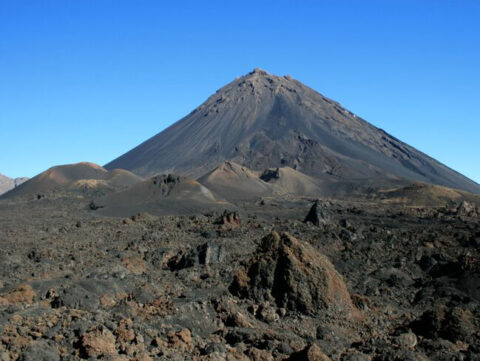What kind of force could lift almost 50 van-sized boulders and hurl them 220 meters (720 feet) above sea level onto a volcanic plateau?
This question puzzled geophysicist Ricardo Ramalho since 2007, when he first came across the mysterious boulders on Santiago Island—a small Atlantic island almost 1000 kilometers due west of Senegal. But it wasn’t until some colleagues found evidence of tsunami deposits on the island in 2011 that Ramalho made the connection—perhaps these boulders are remnants of an extraordinarily huge tsunami, also known as a “megatsunami.”
Ramalho realized there was only one event in the area that was possibly capable of triggering such a towering wave—the Fogo volcano flank collapse.
After dating the boulders, Ramalho realized there was only one event in the area that was possibly capable of triggering such a towering wave—the Fogo volcano flank collapse, where 160 cubic kilometers (40 cubic miles) of rock from the nearby volcano slid off into the ocean. If that collapse, or part of it, had taken place suddenly, the mountain of rock hitting the sea could have triggered a tsunami 240 meters (800 feet) high, Ramalho and his colleagues report—roughly 8 times higher than the greatest peak of the 2004 Sumatra tsunami that killed more than 225,000 people. The largest tsunami ever witnessed by humans was 526 meters (1724 feet) high in Alaska’s Lituya Bay in 1958—but it was able to get that high because it was in a confined space.
“There was no other explanation than a very large tsunami that would have been able to carry the boulders from the cliff edge and cliff face and bring them to the top of the plateau,” said Ramalho, an assistant professor at the University of Bristol in the U.K. He and his team published the research today in Science Advances.
Volcanic Collapse

By studying the tsunami deposits around the Fogo volcano—which is one of the largest and most active volcanoes in the world—previous scientists had dated the collapse to sometime between 65 and 124 thousand years ago. But deposits left over from the collapse tell two different stories.
Some researchers concluded that the Fogo flank collapse happened gradually, with multiple events occurring over days or weeks. However, because a megatsunami is the only explanation for the huge boulders littering Santiago’s plateau, a large collapse must have happened at least initially, Ramalho said.
“We are not the first study to suggest this can happen, we are just providing another line of evidence that actually confirms that this flank collapse might happen suddenly and catastrophically and generate giant tsunamis,” he continued.
The Boulders
Every single one of the 49 boulders that Ramalho and his team found is composed of the same material that makes up the cliffs hundreds of meters below. To find out how long the boulders had been sitting on the plateau, the researchers measured a helium isotope produced in the boulders’ olivine minerals at a known rate by exposure to cosmic rays. Ramalho explained that the amount of the isotope in the boulders’ top surfaces—which would not have been exposed prior to the rocks’ displacement—told his team that the boulders had been sitting atop the plateau for about 73,000 years, which falls within the estimated dates of the Fogo flank collapse.
The researchers also found deposits containing marine jetsam such as shells so high above sea level that the only explanation was an enormous tsunami, Ramalho said.
However, Peter Talling, an expert in sedimentology and geohazards at the National Oceanography Centre in Southampton, U.K., and who wasn’t involved in the research, said that he wasn’t fully convinced that a megatsunami is the only explanation for the boulders’ location.
Boulders can also be placed by a range of less exotic processes.
“It has always been problematic to prove that boulders on land are emplaced by tsunamis,” Talling said. “This is simply because such boulders can also be placed by a range of less exotic processes.”
If the boulders did come from below, a strong storm wave could have done the heavy lifting, Talling said. Or the boulders could have simply rolled from above. Talling suggested that a more thorough mapping of the island is needed to confirm the origins of the boulders.
Gradually or All at Once?
Scientists are not entirely sure what triggers one of the huge volcanic collapses that might have produced a megatsunami, Ramalho said, and there is also controversy surrounding whether the collapses happen in one catastrophic event or gradually, over days or weeks.
Evidence from the Hawaiian Islands in the Pacific Ocean and Canary Islands off the coast of Spain points to megatsunamis created by volcanic flank collapses that happened in one catastrophic event, dumping hundreds of cubic kilometers into the ocean and generating unimaginably large waves. One study even claimed that the Canary Islands are at a huge risk today from a volcano collapse. But these studies were met with a lot of skepticism. More likely, those skeptics say, these volcanic flanks collapse in multiple, smaller landslides that create tsunamis that are less spectacular but still hazardous.
In the new study, the authors concede this point and offer a solution—that the Fogo volcano flank collapse occurred initially as one, large event, spurring the 800-foot (240-meter)-high wave, followed by multiple, smaller events.
Modern-Day Risks
Ramalho stresses that although these events can occur and have occurred in the past, they are very rare, so there is little risk. Studying these events should inform our understanding of the hazards associated with large ocean volcanoes, but there is no evidence that a volcano flank collapse is imminent, Ramalho said, at Fogo or elsewhere.
—JoAnna Wendel, Staff Writer
Citation: Wendel, J. (2015), Mysterious boulders suggest ancient 800-foot-tall tsunami, Eos, 96, doi:10.1029/2015EO036845. Published on 2 October 2015.
Text © 2015. The authors. CC BY-NC 3.0
Except where otherwise noted, images are subject to copyright. Any reuse without express permission from the copyright owner is prohibited.

